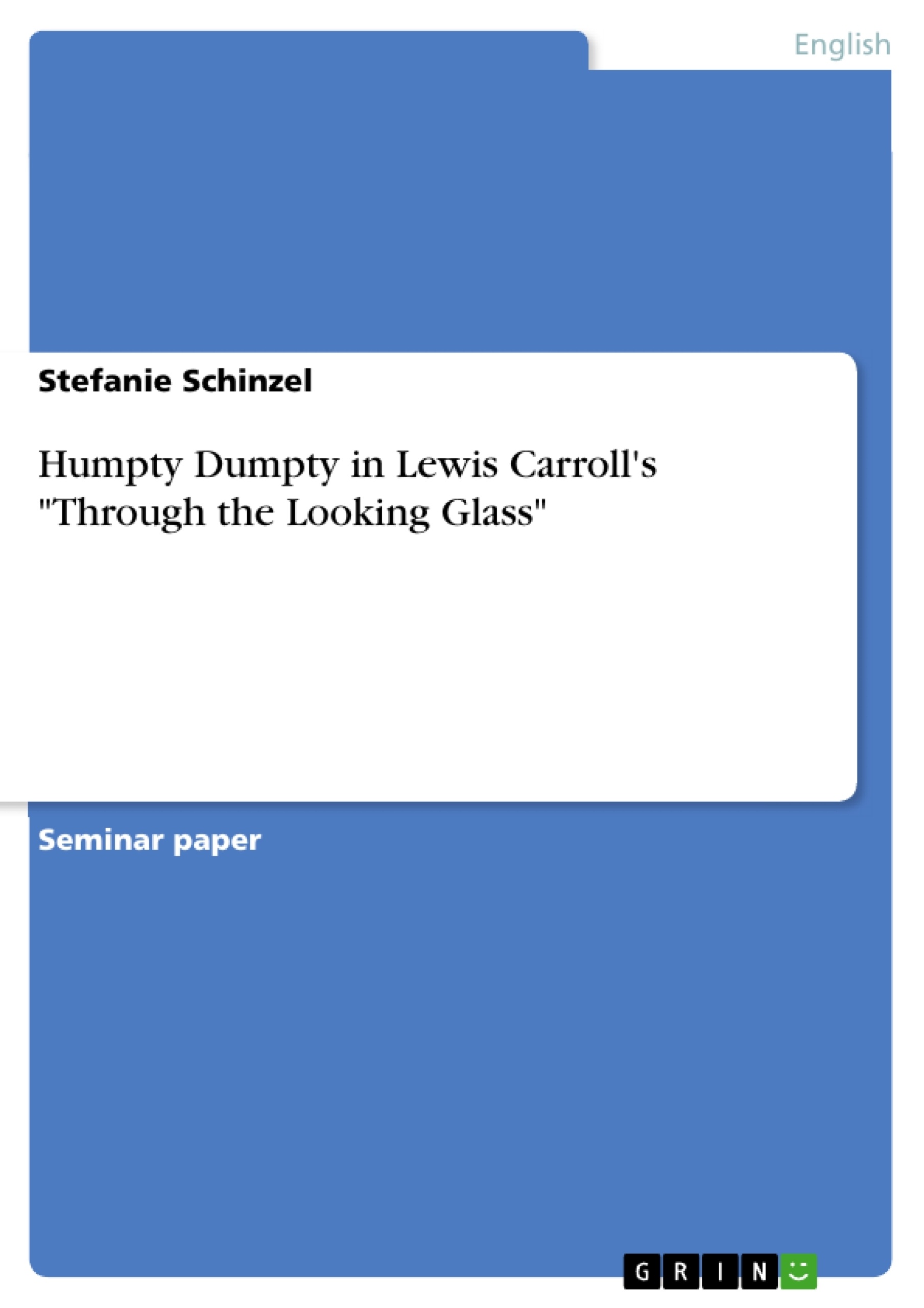I guess, nearly everybody knows about Alice's Adventures in Wonderland from their childhood experiences. This book, andThrough the Looking Glass,were written by Charles Lutwidge Dodgson who is better known by his pen-name Lewis Carroll. His main contribution is to be found in children's literature. In my following work I will concentrate on the scene between Alice and Humpty Dumpty. Because Humpty Dumpty is very well known especially by british children, he is one of the main characters in the bookThrough the Looking Glass.Many children are able to tell the little nursery rhyme about him, which goes: "Humpty Dumpty sat on a wall: Humpty Dumpty had a great fall. All the King's horses and all the King's men Couldn't put Humpty Dumpty in his Place again." For this is the chapter which is unique in the linguistic sense, I divided it in several parts to analyze it best. These are the topics of which Alice and Humpty speak.
Table of Contents
- I. Introduction
- II. Structure of Chapter VI. in Through the Looking Glass
- II.1 Humpty Dumpty's appearance in the beginning
- II.2 Humpty's shape and Names and meanings
- II.3 Humpty Dumpty's position
- II.4 Talking about age
- II.5 Belt or cravat
- II.6 Un-birthday discussion and Calculation
- II.7 Words and their meaning
- II.8 The Jabberwocky
- II.9 Humpty's poem
- II.10 Alice's face
- III. Conclusion
Objectives and Key Themes
This paper analyzes the scene between Alice and Humpty Dumpty in Lewis Carroll's Through the Looking Glass, focusing on the linguistic aspects of their conversation. The objective is to explore how Carroll uses language and wordplay to create a unique and memorable encounter, highlighting the themes of language, identity, and meaning.
- The nature of language and its meaning
- The creation of identity and self-perception
- The interplay between fantasy and reality
- The use of wordplay and nonsense in literature
- The interpretation of names and their significance
Chapter Summaries
I. Introduction: This introductory chapter sets the stage for the analysis by establishing the context of Lewis Carroll's Alice books and introducing Humpty Dumpty as a significant character, particularly known through the famous nursery rhyme. It highlights the linguistic uniqueness of the Humpty Dumpty chapter within Through the Looking Glass and explains the structure of the subsequent analysis, which will focus on the key themes in the dialogue between Alice and Humpty Dumpty.
II. Structure of Chapter VI.: This chapter delves into a detailed analysis of Chapter VI of Through the Looking Glass, focusing on the conversation between Alice and Humpty Dumpty. It meticulously examines various aspects of their interaction, beginning with Humpty Dumpty's initial appearance as a giant egg resulting from a metamorphosis of Alice's surroundings. The analysis then explores Humpty Dumpty's shape, his name, and its meaning. This is followed by discussion of their conversation around age, Humpty Dumpty's clothing, their discourse on un-birthdays, the nature of words and their meaning, the Jabberwocky, Humpty Dumpty's poem, and the interaction around Alice's facial expressions. The chapter employs textual evidence and references to Carroll's work, and external scholarly sources like Lecercle's "Philosophy of Nonsense" to provide a thorough investigation into the linguistic intricacies of the chapter, demonstrating how Carroll plays with language, meaning, and identity.
Keywords
Lewis Carroll, Through the Looking Glass, Humpty Dumpty, language, meaning, identity, wordplay, nonsense literature, fantasy, reality, linguistic analysis, character analysis, nursery rhyme.
Through the Looking Glass: A Linguistic Analysis - FAQ
What is the purpose of this document?
This document provides a comprehensive preview of a linguistic analysis of the encounter between Alice and Humpty Dumpty in Lewis Carroll's Through the Looking Glass. It includes the table of contents, objectives, key themes, chapter summaries, and keywords.
What are the key themes explored in the analysis?
The analysis focuses on the linguistic aspects of the Alice and Humpty Dumpty conversation, exploring themes such as the nature of language and its meaning, the creation of identity and self-perception, the interplay between fantasy and reality, the use of wordplay and nonsense in literature, and the interpretation of names and their significance.
What is the structure of the analysis?
The analysis is structured into three main parts: an introduction, a detailed analysis of Chapter VI of Through the Looking Glass, and a conclusion. The core analysis meticulously examines various aspects of the Alice and Humpty Dumpty interaction, including Humpty Dumpty's appearance, his name and meaning, their discussion of age and un-birthdays, their exploration of word meanings, the Jabberwocky poem, and Alice's reactions.
What specific aspects of Chapter VI are analyzed?
The analysis of Chapter VI covers Humpty Dumpty's appearance, shape, name and meaning, the discussion about age, his clothing (belt or cravat), the un-birthday discussion and its calculations, the meaning of words, the Jabberwocky poem, Humpty Dumpty's own poem, and Alice's facial expressions. It uses textual evidence from Through the Looking Glass and references external scholarly sources.
What sources are used in the analysis?
The analysis draws upon Lewis Carroll's Through the Looking Glass as its primary source. It also mentions the use of external scholarly sources, such as Lecercle's "Philosophy of Nonsense," to support its interpretations.
What are the keywords associated with this analysis?
The keywords include: Lewis Carroll, Through the Looking Glass, Humpty Dumpty, language, meaning, identity, wordplay, nonsense literature, fantasy, reality, linguistic analysis, character analysis, and nursery rhyme.
What is the overall objective of the analysis?
The objective is to explore how Lewis Carroll uses language and wordplay to create a unique and memorable encounter between Alice and Humpty Dumpty, highlighting the themes of language, identity, and meaning within the context of Through the Looking Glass.
Where can I find more information about this analysis?
The provided preview offers a comprehensive overview. The full analysis would contain a more in-depth exploration of the themes and aspects detailed in this preview.
- Citar trabajo
- Stefanie Schinzel (Autor), 2001, Humpty Dumpty in Lewis Carroll's "Through the Looking Glass", Múnich, GRIN Verlag, https://www.grin.com/document/60319



